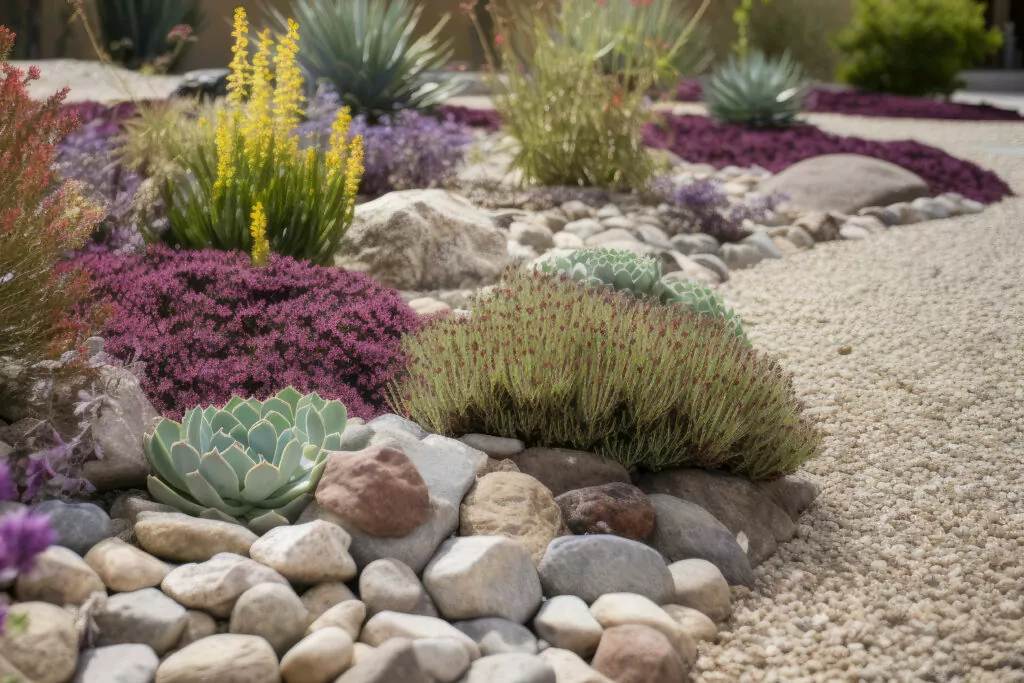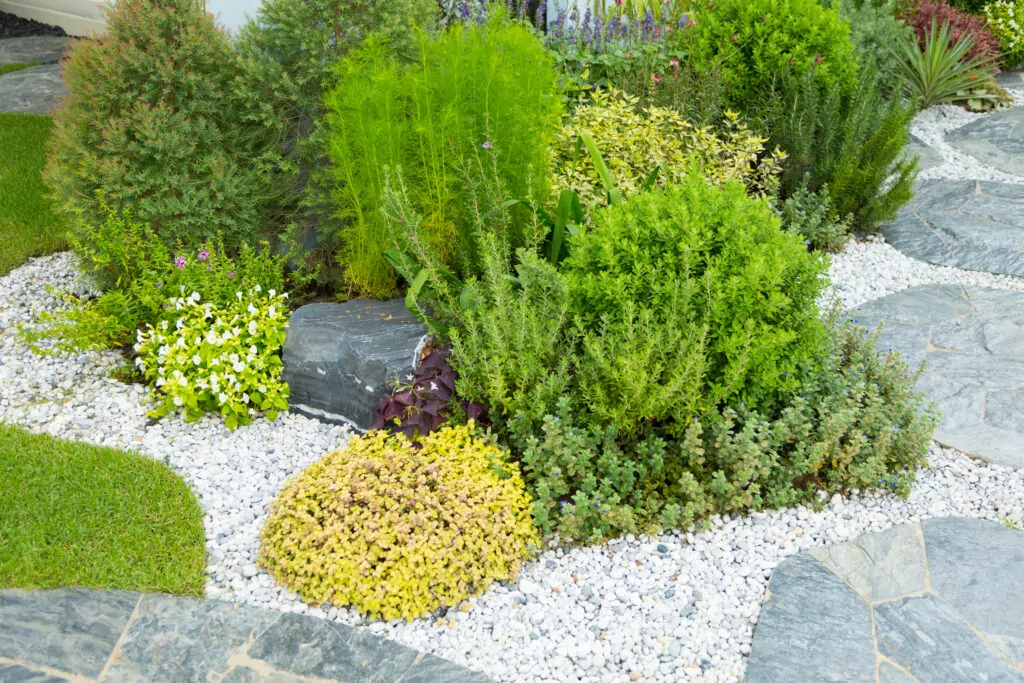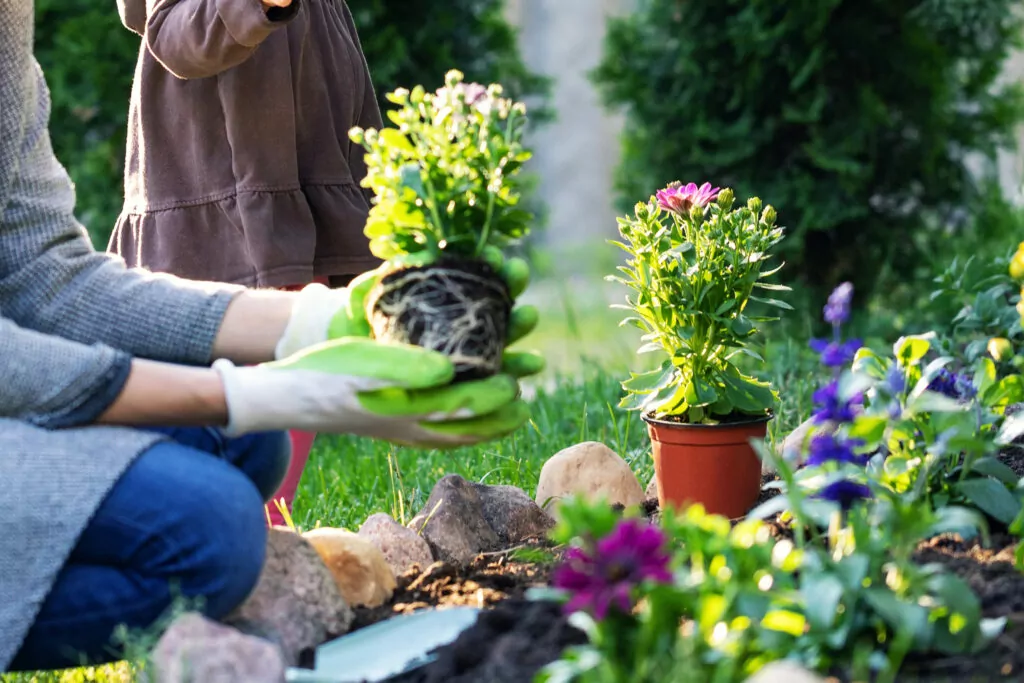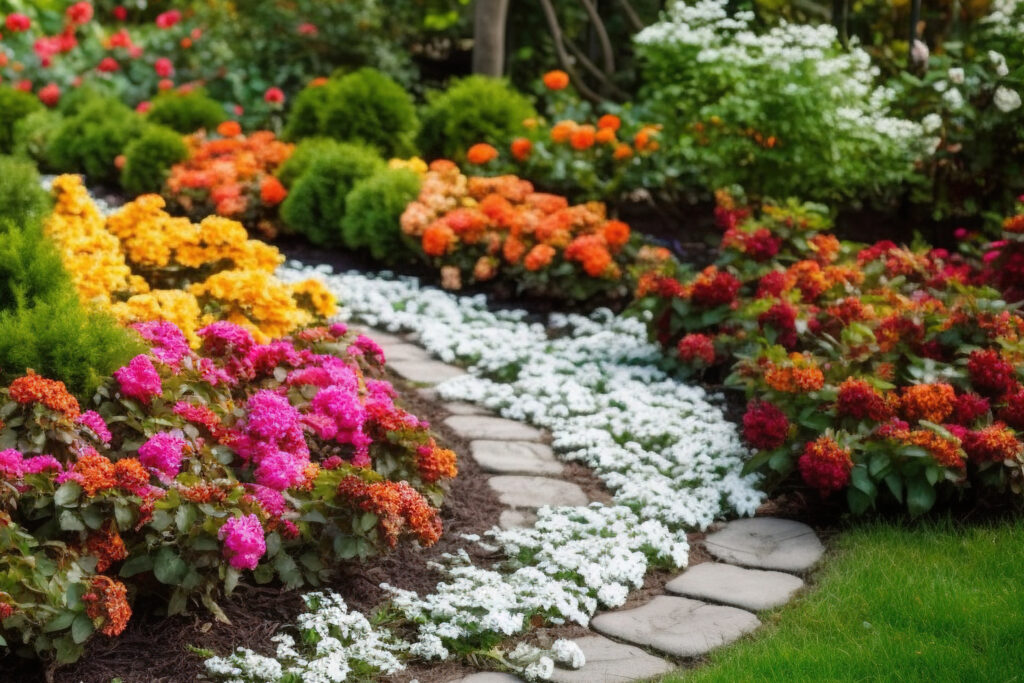Who doesn’t love the idea of stepping outside and being greeted by a vibrant array of color and fragrances? When it comes to landscaping ideas, flower beds can transform even the simplest yard spaces into havens of beauty and tranquility. They can attract pollinators, inspire creativity, and even add curb appeal—and potential value—to your home.
Whether you’re a seasoned gardener or someone with a budding green thumb, this DIY guide will help you sort through new flower bed ideas and helpful tips for getting them right. From whimsical arrays of wildflowers to geometrically shaped layouts, there are endless possibilities to make your outdoor space reflect your unique style!
20 Flower Bed Ideas to Beautify Your Garden
Curious what to put in a flower bed or how you can make your home garden ideas a reality? Each one of your flower beds will be different, so check out the following suggestions to jumpstart a new yard design that will work for your space.
1. Flower Walkway

A classic flower bed design option is to have one or more gardens lining your front yard or backyard walkways. Transform your pathway into a blooming spectacle with vibrant edging plants like alyssum, snapdragons, or petunias. Also consider low-growing perennials like creeping thyme or coral bells for a fragrant, effortless touch. Finally, don’t forget to explore your own taste to find flowers that look good together!
2. Succulents As Flower Beds

When considering flower bed ideas, don’t overlook the low-maintenance allure of succulents! You can combine various textures, colors, and shapes for a modern and drought-resistant option. Types of succulents to consider are echeveria, sempervivum, or aloe vera. Just be careful when you’re walking, because some succulents have sharp spikes that can scratch you if you’re not careful.
3. Combine Flowers and Vegetables

Want to live greener and maximize your flower garden space for food harvests? Intersperse edible delights like lettuce, peppers, and herbs with beautiful and eye-catching flowers like zinnias, cosmos, and marigolds. Combining a vegetable garden with your flowers is also one of those cheap flower bed ideas that can also save you money at the grocery store!
4. Color-Pattern Flower Beds

When considering new landscaping for your flower bed ideas, don’t forget the obvious: colors! Create a fiery look with reds, oranges, and yellows that you can find in flowers like bleeding hearts, black-eyed susans, butterfly weed, or chrysanthemums. Or consider evoking serenity with a cool pallet of blues, purples, and lavenders with anemones, asters, or bugloss.
5. Flowers That Look Good Together

Unsure about pairings for your flower beds? Opt for tried-and-true combinations like roses and lavender, daisies and coneflowers, or tulips and daffodils. These classic duos will give your bed of flowers both harmony and visual appeal! If you’re feeling creative, try mixing and matching your personal taste to discover your own opinion of flowers that look good together.
6. Seasonal-Color Flower Beds

When it comes to new flower bed design ideas, try letting nature be your guide by designing beds that evolve with the seasons. Plant spring bulbs like tulips and daffodils for an early burst of color, and follow that with vibrant summery annuals like zinnias, impatiens, or border dahlias. Once autumn’s fiery foliage arrives, plan to have some marigolds and lantanas to match the turning leaves around your neighborhood.
7. Gravel Yard With Flowers

Gravel or mulch in your landscape design doesn’t have to be monotonous when you can break the spread of it up with colors! Plant year-round, drought-tolerant plants like succulents, cacti, and ornamental grasses, or add flowering shrubs that can thrive well in dryer conditions. Even in more temperate climates, consider carving out areas in a spread of gravel or mulch for regular gardens filled with your favorite type of seasonal flowers.
8. Tall Plants

Add some drama and dimension to your flower beds with strategically placed taller flowering plants like hollyhocks, sunflowers, or boxwood. These focal points will give your outdoor space a dash of visual interest and structure, especially if you have larger flower beds.
9. Butterfly Sanctuary

Building a sanctuary to attract colorful, winged visitors like butterflies can be a cheap flower bed idea that gives something back to nature. To do this, plant nectar-rich flowers like butterfly bush, milkweed, and coneflowers. These plants can create a haven for butterflies and help them survive during their long migrations each season.
10. Cottage Garden Charm

Bring cottage core outdoors by mixing a variety of perennials, annuals, and herbs for a sense of abundance and informal beauty in your bustling garden. If you’re not sure what type of flowers to plant, consider roses, daisies, and fragrant herbs like basil and thyme. Mixing an herb garden with native plants—or even a tree stump or two—is a great way to bring your outdoor space back to nature no matter where you live!
11. Moonlight Garden

Cast an enchanting spell at night with blooms that glow in the moonlight! White flowers like moonflowers, nicotiana, and primroses release their fragrances after dusk, which can create a magical atmosphere for nighttime gatherings once the sun goes down.
12. Edible Flowers

Flowers aren’t just for decoration! Some are edible, and they can add color to your garden while also adding beauty to your plate. Consider flowers like pansies, violas, and calendula for vibrant options that you can later harvest and add to your meals for unique, unexpected garnishes.
13. Monochromatic Gardens

Have you ever imagined what your garden might look like with just a single color of flower? Try it out for a season to watch your yard pop! Choose from shades like purples, pinks, or whites for a sophisticated and unified look that will make your house stand out.
14. Water Feature Garden

If you’re tired of just having flowers, consider adding the soothing sound of water to your garden! Incorporate a small fountain, birdbath, or pond to your space to attract feathered friends and create a sense of peace and tranquility. Around the water feature, plant some colorful perennial flowers like daylilies, columbine, or irises.
15. Upcycled Elegance

Sometimes, your old treasures just need a new lease on life—with container gardening. Use vintage watering cans, bathtubs, or wheelbarrows as unique planters for a fun, sustainable, and natural look. Mix garden soil, compost, and peat moss together, and then fill it into your container before planting your favorite flowers.
16. Rock Gardens

Are you the low maintenance type? Try creating a visually striking rock garden! Fill spaces between the rocks with drought-tolerant succulents, sedums, and ornamental grasses for a textured, captivating display. If you prefer flowers, you can still create a rock garden—just leave space for soil wherever you want to see pops of color.
17. Climbing Vine Wall

Don’t forget about vine plants that can build a world of their own! Clematis, red trumpet vine, and wisteria flowers can climb trellises, fences, and pergolas for a burst of vibrant color and pleasant fragrances. Choose varieties that bloom throughout the season so you can get the most enjoyment out of them, and make sure you live in a climate that allows them to return the following year.
18. Woodland Sanctuary

If you’re the woodsy type, try creating a woodland-inspired garden! Plant ferns, hostas, and bleeding hearts for ground cover alongside shade-loving perennials that don’t need full sun—think toad lilies, lungwort, or brunnera. These plants can all survive in the shade and will turn any space into a tranquil, forest-like oasis.
19. Bee-Friendly Flower Beds

Bees are vital pollinators that are currently being threatened by industrial use of pesticides. Give them a space to play their essential environmental role by planting an array of goldenrod, bee balm, black eyed susans, and marigolds. These are just a few varieties, so do your research to discover what colors you—and the bees—would like to see most!
20. Raised Flower Beds

If your yard has uneven terrain, consider doing some hardscaping to build raised beds that will let you make the most of your garden space. These offer optimal drainage and can make gardening easier on the back. When planting flowers, get creative by the season! Top options for flowers to plant in a raised garden bed are poppies, begonias, and sunflowers.
Flower Bed Design FAQs
Still have questions about flower bed design ideas? Check out answers to common questions below!
What to put in a flower bed?

Deciding what to put in your flower bed depends on a few key factors, including sun exposure and soil type, color palettes, and maintenance needs.
Sandy soil is great for succulents. Damp soil is good for moisture-loving plants like lilies, hostas, and astribes. Finally, acidic soil is good for rhododendrons, azaleas, and hydrangeas. Make sure you know your soil requirements for the plants you choose!
As for color palettes, choose the hues you like! Some flowers come in multiple colors, so also consider using versions of the same flower across your flower beds.
If you love gardening, you can opt for higher- or moderate-maintenance flowers like daylilies, marigolds, or roses. If you’re the low-maintenance type, try perennials or succulents!
What is a cheap flower bed idea?

Transforming your outdoor space doesn’t always require a high budget! Try repurposing old buckets, tires, or bathtubs to make rustic and interesting flower containers. Since perennials tend to multiply over time, ask friends or neighbors if they’d be willing to split or swap plans that have overgrown their spaces. Otherwise, try planting native wildflowers! Seeds are very affordable, and the flowers that eventually bloom can create a stunning, low-maintenance garden while also attracting pollinators.
How to lay out flowers in a flower bed?

Part of the fun of gardening is designing a layout that you can enjoy for years to come. Here are some tips for bringing your floral vision to life:
- Sketch it out. Grab a pen and paper or use a gardening app to brainstorm and visualize your layout. Consider your proposed flower bed’s size, shape, and sun exposure.
- Know your plants. Understand the mature size, height, and light requirements of each plant you choose. This will help you space them appropriately!
- Think in layers. Create a visually interesting and balanced design by planning in layers. Taller plants should go in the back, and shorter edging plants should go in the front.
- Consider color and texture. Play with contrasting colors to create complementary hues. You can also mix different foliage textures like ferns, hostas, or spiky grasses to add depth.
- Prepare and plant! Ensure your soil is well draining and full of the appropriate nutrients for your chosen plants. Start with the biggest plants first before filling in the middle or edge areas of your flower bed. Finally, add a layer of mulch around your plants to retain moisture, suppress weeds, and regulate soil temperature.
Are you a flower beginner or simply feeling unsure where to start? Talented and experienced Taskers are just a few clicks away! They can help you with your garden design or install and maintain stunning flower beds that will last you a lifetime. So why wait? Hire a Tasker now.














